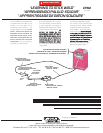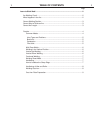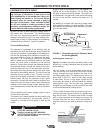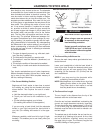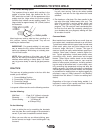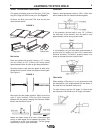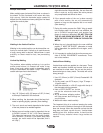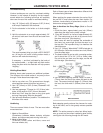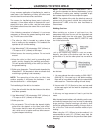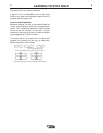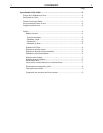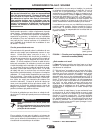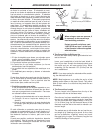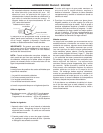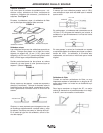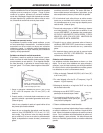
3
LEARNING TO STICK WELD
3
The function of the covered electrode is much more
than simply to carry current to the arc. The electrode
is composed of a core of metal wire around which has
been extruded and baked a chemical covering. The
core wire melts in the arc and tiny droplets of molten
metal shoot across the arc into the molten pool. The
electrode provides additional filler metal for the joint
to fill the groove or gap between the two pieces of the
base metal. The covering also melts or burns in the
arc. It has several functions. It makes the arc stead-
ier, provides a shield of smoke-like gas around the
arc to keep oxygen and nitrogen in the air away from
the molten metal, and provides a flux for the molten
pool. The flux picks up impurities and forms the pro-
tective slag. The principal differences between vari-
ous types of electrodes are in their coatings. By vary-
ing the coating, it is possible to greatly alter the oper-
ating characteristics of electrodes. By understanding
the differences in the various coatings, you will gain a
better understanding of selecting the best electrode
for the job you have at hand. In selecting an electrode
you should consider:
1. The type of deposit you want, e.g. mild steel, stain-
less, low alloy, hardfacing.
2. The thickness of the plate you want to weld.
3. The position it must be welded in (downhand, out
of position).
4. The surface condition of the metal to be welded.
5. Your ability to handle and obtain the desired elec-
trode.
Four simple manipulations are of prime importance.
Without complete mastery of these four, further weld-
ing is more or less futile. With complete mastery of
the four, welding will be easy.
1. The Correct Welding Position
Beginners will find it easier to learn how to control
the welding arc using the two-handed technique
shown below. This requires the use of a head-
shield.
a. Hold the electrode holder in your right hand.
b. Touch your left hand to the underside of your
right.
c. Put the left elbow against your left side.
(For welding left-handed it is the opposite.)
If you are using a hand shield, hold the electrode
holder in your right hand and the hand shield in
your left. (For welding left-handed it is the oppo-
site.)
Whenever possible, weld from left to right (if right-
handed). This enables you to see clearly what you
are doing.
Hold the electrode at a slight angle as shown.
ARC RAYS can burn eyes and skin.
When using an open arc process, it
Is necessary to use correct eye,
head and body protection.
Protect yourself and others, read
“ARC RAYS can burn” at the front
of the Operator’s Manual supplied
with the welder.
-----------------------------------------------------------------------
2. The Correct Way to Strike an Arc
Be sure the work clamp makes good electrical con-
tact to the work.
Lower your headshield or hold the hand shield in
front of your face. Scratch the electrode slowly over
the metal and you will see sparks flying. While
scratching, lift the electrode 1/8" (3.2mm) and the
arc is established.
NOTE: If you stop moving the electrode while
scratching, the electrode will stick.
NOTE: Most beginners try to strike the arc by a fast
jabbing motion down on the plate. Result:
They either stick or their motion is so fast
that they break the arc immediately.
3. The Correct Arc Length
The arc length is the distance from the tip of the
electrode core wire to the base metal.
Once the arc has been established, maintaining the
correct arc length becomes extremely important.
The arc should be short, approximately 1/16 to 1/8"
(1.6 to 3.2mm) long. As the electrode burns off the
electrode must be fed to the work to maintain cor-
rect arc length.
The easiest way to tell whether the arc has the cor-
rect length is by listening to its sound. A nice, short
arc has a distinctive, “crackling” sound, very much
like eggs frying in a pan. The incorrect, long arc has
a hollow, blowing or hissing sound.
WARNING



